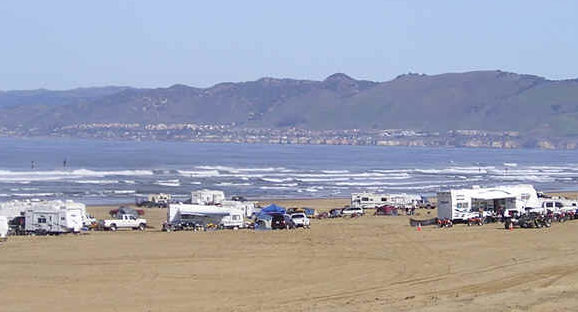Research study undercuts APCD Oceano Dunes dust claims
October 4, 2020

By KAREN VELIE
A preliminary report from the prestigious Scripps Institution of Oceanography casts additional doubt about the need to reduce dust blowing from the Oceano Dunes onto the Nipomo Mesa. Analyses of airborne particulate samples show that blowing sand from the Oceano Dunes State Vehicular Recreation Area does not pose a health risk to people living on the Mesa, Scripps scientists said.
The state of California has spent millions of dollars to reduce dust from the Oceano Dunes following claims by the San Luis Obispo County’s Air Pollution Control District (APCD) that toxic crystalline silica posed a health risk for people living on the Mesa.
The APCD has said that 100 percent of airborne particulates blowing on the Mesa is mineral dust from the Oceano Dunes. But halfway through the Scripps Institute’s three-year study, samples from collectors on the Mesa found that only one fifth of the samples consisted of the dust.
“Twenty-six samples taken in May, the dust was less than 20 percent,” said Lynn Russell, PhD, a professor of atmospheric chemistry at the graduate department at U.C. San Diego, Scripps Institution of Oceanography. “It is exactly 20 percent on average for the higher pm 10 days. The rest was not dust and didn’t have the dunes as a source.”
San Luis Obispo County’s Air Pollution Control District (APCD) Director Gary Willey dismissed the Scripps report, and continues to blame vehicle traffic on the dunes as the primary cause of air-borne particles on the Mesa. Willey’s LinkedIn profile lists his academic credentials as a bachelor’s degree in mechanical engineering.
Aside from the 20 percent mineral dust, the airborne particles were largely comprised of water from “ambient relative humidity” and other compounds not associated with the dunes, according to the Scripps report.
The Scripps scientists focused on smaller particles of dust, 2.5 microns or less in diameter, because of health concerns. While smaller particles can enter the lungs, larger particles are generally captured in the mucus membranes of the nasal passages and are not a health risk.
In addition, the airborne sea salt and the mineral dust derived from the dunes are not toxic, according to the Scripps report.
“It is worth noting that there is no evidence that toxic compounds are associated with the two major PM2.5 sources (dune dust and sea spray) during windy conditions at Oceano Dunes, so association of PM2.5 with detrimental health effects may be without foundation,” according to the report.
In Nov. 2011, the APCD board voted to adopt “the dust rule” based on their own Phase 2 report, which blamed recreation on the Oceano Dunes for high dust levels two to four miles away on the mesa, with a claim that the dust was mainly silica.
“While not specifically measured in the study, crystalline silica can be a significant portion of wind-blown sand and soil, and is a known lung cancer hazard,” according to the APCD at a time the agency admitted that they did not know if the airborne dust actually contained the mineral silica because it was “not specifically measured in the study.”
But that did not stop then-APCD Director Larry Allen from making a dubious claim to the California Coastal Commission.
“Public exposure to unacceptably high levels of particulate matter, much of which occurs in the form of highly toxic crystalline silica, have continued to impact downwind residents,” Allen wrote in a letter to California Coastal Commission Deputy Director Dan Carl on March 27, 2017.
After 10 years of warning Nipomo residents of the dangers of silica dust, the APCD decided to run tests for silica in the air. The testing refuted the APCD’s earlier claims; concluding the dust blowing from the dunes did not contain dangerous levels of crystalline silica.
Even so, in 2018, State Parks entered into a stipulated order of abatement with the APCD. The order requires the state reduce wind-blown dust, specifically dust particles that are 10 microns or less in diameter, on the Nipomo Mesa by 50 percent. Despite agreeing to the various terms in the order, State Parks still denied that off-roading causes the dust on the mesa.
Over the past 10 years, the state has spent more than $15 million in taxpayer revenue to reduce dust concentrations on the mesa. State Parks covered approximately 200 acres of dune sand with hay, vegetation or orange plastic fencing in effort to reduce wind-blown dust.
Meanwhile, California Coastal Commission staff, which became involved because of the APCD-derived false concerns that silica from the dunes was harming the health of people living on the Mesa, is pushing to shut down the Oceano Dunes State Vehicular Recreation Area over the next five years.






The comments below represent the opinion of the writer and do not represent the views or policies of CalCoastNews.com. Please address the Policies, events and arguments, not the person. Constructive debate is good; mockery, taunting, and name calling is not. Comment Guidelines